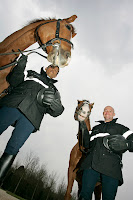Recientemente he descubierto que Sir Arthur Conan Doyle, el creador del archiconocido detective, Sherlock Holmes, menciona la villa de Mondescourt (y otras cercanas como Noyon, Grandru, Appilly, Baboeuf, Béthencourt...) en sus escritos.
 |
| Fuente: Project Gutenberg Australia |
Al estallar la 1ª Guerra Mundial, Sir Arthur intentó alistarse, pero a sus 55 años no se lo permitieron. Este hecho no le impidió que participara, no sin penurias, haciéndose cronista de la misma en su obra extremadamente detallada:
The British Campaign in France and Flanders: 1914.
En su Volumen V, cap. VII. The Second Battle of the Somme.The Retreat of the Third Corps, describe la retirada de tropas británicas y francesas a la línea Mondescourt-Grandru, por la presión de las tropas alemanas en su avance por el Oise:
"The first movement in this withdrawal was to the line Mondescourt—Grandru, and the second to the line Appilly—Baboeuf—Mont de Béthéricourt. By 8:30 the Eighteenth Division in the middle of the line was effecting this retirement, the northernflank, which was the post of danger, being covered by the 11th Royal Fusiliers of the 54th Brigade. It was a most difficult and delicate business with the enemy pressing down continually through the woods and villages with which thecountry is studded. On the south the 53rd Brigade and the French Cuirassiers were withdrawing through Mondescourt in some disorder. When the troops wererallied and rearranged, there were no French troops upon the right."
Enclavada este área en una de las más cruentas batallas de la 1ª Guerra Mundial (y de la historia), por el desgaste que supuso en vidas humanas en ambos bandos, no es extraño encontrar vestigios de la misma por toda la región, mezclados con los de la 2ª Guerra Mundial.




